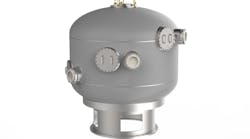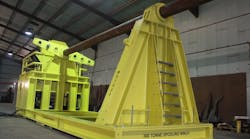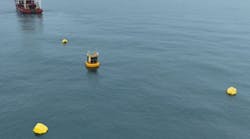Editor's note: This Offshore Wind Energy section first appeared in the September-October 2022 issue of Offshore magazine. Click here to view the full issue.
By Bruce Beaubouef, Houston
Offshore wind alliance targets projects in Iberian peninsula
IberBlue Wind has started operations in Spain and Portugal, targeting development of floating offshore wind farm projects.
Its three backers are:
- Simply Blue Group, a developer of floating offshore wind farms in Ireland, the UK, US, Poland and Sweden, with 10 GW of projects under development;
- Proes Consultores, the engineering and architecture division of the Amper Group that provides engineering, industrial and technological services (Proes has participated in the design of the Kincardine floating wind project offshore Scotland); and
- FF New Energy Ventures, which develops, builds and operates solar photovoltaic and renewable energy plants in Spain and Portugal.
IberBlue Wind will participate in public auctions for offshore sites off Spain and Portugal and will offer to perform early development and design of projects in advance of the construction and commissioning of wind turbines.
It aims to develop about 2 GW of floating offshore wind capacity off the Iberian Peninsula, comprising wind farms each of 500 MW or more.
Its initial focus in Spain will be on Andalusia in the south, promoting offshore wind energy as a new economic driver for the region; and Galicia in the northwest, one of the regions with the best conditions for offshore wind.
Off Portugal, the alliance will target opportunities in the central and northern regions, which again offer a strong wind energy resource.
TotalEnergies, Danish research institute to establish wind/clean energy facility
TotalEnergies and the Technical University of Denmark (DTU) will jointly create a new research facility, the DTU-TotalEnergies Excellence Center of Clean Energy.
Its focus will be on developing reliable, low-emission energy solutions to reduce the intermittence of renewable energy and speed up de-carbonization of industrial sites.
The new center will be housed on the premises of the DTU at the Risø campus, west of Copenhagen. According to TotalEnergies, the DTU is recognized for its research into offshore wind energy.
The center will have three main areas of focus:
- Construction of a next-generation hybrid electric platform: a pilot scheme at the Risø power plant will test different systems for optimizing production of wind energy with battery storage systems and the production of green hydrogen, with the results used for research programs.
- Multi-energy training for TotalEnergies employees, including online ‘masterclasses’ and specially designed courses on electricity and clean energy.
- Research partnerships: TotalEnergies’ researchers and engineers will work with the DTU's teaching staff, researchers and students on programs for the joint development of solutions including next-generation wind technologies and floating wind farms.
US govt reveals next steps for Gulf of Maine offshore wind development
The US Department of the Interior has issued the next steps required for developers to bring offshore wind energy to the Gulf of Maine. The Bureau of Ocean Energy Management (BOEM) has made available a Request for Interest (RFI) and Request for Competitive Interest (RFCI) in the Federal Register for public comment.
The publication of these two requests for public comment represents one of the many steps BOEM has taken to acquire the best available information and knowledge for its decision-making, the Interior Department said.
The RFI is the first step in BOEM’s commercial planning and leasing process to identify the offshore locations that appear most suitable for development, taking into consideration potential impacts to other resources and ocean users. The purpose of the RFI is to gauge interest in the development of commercial wind energy leases within the RFI Area, which consists of about 13,713,800 acres in the Gulf of Maine.
Through the RFI, BOEM seeks feedback from stakeholders, industry, Tribes, ocean users and others regarding the location and size of specific areas they wish to be included in (or excluded from) a future offshore wind energy lease sale, along with other planning considerations. This information will be used to narrow the area to be considered for offshore wind development as BOEM moves forward with the Gulf of Maine planning and leasing process.
The RFCI is the next step in processing the State of Maine’s application for a research lease and provides notice of the proposed research area that Maine requested. BOEM is issuing this RFCI because the Outer Continental Shelf Lands Act and implementing regulations require that BOEM determine whether competitive interest exists in any area that is the subject of an unsolicited lease request.
If BOEM does not receive any indications of competitive interest for a lease in response to this notice, BOEM will move forward with the research application. However, if one or more indications of competitive interest from qualified entities are submitted, BOEM may decide to move forward with the lease issuance process using competitive leasing procedures.
Maine’s application requests 9,700 acres on the Outer Continental Shelf more than 20 nautical miles off the Maine coast. If developed, the research array would comprise up to 12 floating offshore wind turbines capable of generating up to 144 megawatts of renewable energy. BOEM invites submission of indications of commercial interest, as well as comments from interested and affected parties.
The RFCI Area (68,320 acres) expands upon Maine’s requested research lease area to allow future siting flexibility to avoid or minimize conflicts with existing ocean users should a lease (research or commercial) be issued. Only a project that is approximately the size of Maine’s research lease proposal (i.e., no more than 10,000 acres and no more than 12 floating turbines) and provides a conceptual framework for addressing the research priorities identified in the RFCI will have the potential to move forward.
By 2025, the Interior Department plans to hold up to five additional offshore lease sales and complete the review of at least 16 plans to construct and operate commercial, offshore wind energy facilities, which would represent more than 22 GW of clean energy for the nation.





